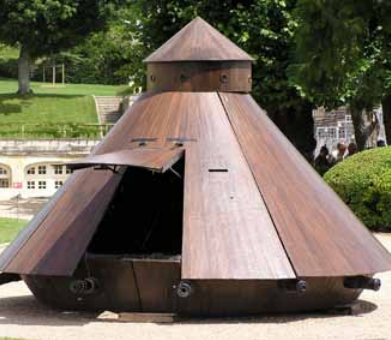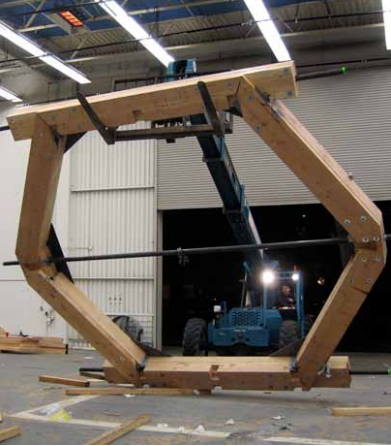By Alan Earls
In this article, we look at Leonardo Da Vinci’s sketches of proto-machine tools, including lathes and screw machines, which he conceived hundreds of years before they were ever built.
These days, thanks to books, movies, a Discovery Channel reality show, and innumerable global museum exhibits, that penultimate renaissance man, Leonardo Da Vinci, is among the most popular of the tribe known as dead white males. Dan Brown made him a central figure in his novel, The Da Vinci Code, where his art (and sexual proclivities) are analyzed ceaselessly by scholars and pundits. For every gear-head, engineer, scientist and nerd, there is always the attraction of his mechanical inventions, most famously including military tanks, helicopters and multiple barrel artillery.
It turns out, though, that among Leonardo’s inventions there is a whole collection of proto-machine tools. For instance, around the year 1500, the artist-turned-engineer sketched a lathe with a three-bearing head stock as well as a screw cutting machine. The latter consisted of a flat table with a “cutter block” sliding across at right angles to the material being threaded. The crank, which rotates the stock, also “feeds” the cutting block through a series of gears, at a rate designed to produce a specific thread pitch. Da Vinci’s drawing includes illustrations of alternative gears, which would allow for different screw pitches to be cut on the same machine.
He conceived the lathe as treadle powered, and appears to have envisioned it as another way to cut screw threads. A different drawing by Leonardo shows a lathe also powered by a treadle, however, in this case the crank is supported by two bearings to enhance rigidity, and beyond the crank, a flywheel has been added to the design to produce steadier, uni-directional rotation. The tailstock on this lathe is fixed, but a threaded centerpiece permits handling of work pieces of various lengths.
 Leonardo also made a very detailed drawing for a pipe-boring mill. The design was considered so complete that a scale model was crafted from it and put on display at the London Science Museum. According to A Short History of Machine Tools by L.T.C. Rolt, “The most remarkable feature of this machine is that the screw clamps which hold the workpiece in position for boring are interconnected by pinions with a ring gear, so as to be self-centering,” anticipating the design of the self-centering chuck.
Leonardo also made a very detailed drawing for a pipe-boring mill. The design was considered so complete that a scale model was crafted from it and put on display at the London Science Museum. According to A Short History of Machine Tools by L.T.C. Rolt, “The most remarkable feature of this machine is that the screw clamps which hold the workpiece in position for boring are interconnected by pinions with a ring gear, so as to be self-centering,” anticipating the design of the self-centering chuck.
As if those achievements weren’t enough, Leonardo also sketched a wide array of grinders, including one designed to grind curved mirrors and an “internal” grinder. Not bad for a contemporary of Christopher Columbus.
However, like Leonardo’s helicopters, military vehicles and host of other fascinating conceptions, there is no evidence that he or his contemporaries ever attempted to actually build the machine tools he sketched. It was, it seems, “the thought” that counted. The world went on its way for a few more centuries before others, independently, came to conclusions that were similar to the ultimate Renaissance man.
Valek Sykes, a special effects expert and mechanical designer, as well as a “star” of the Discovery Channel show Doing Da Vinci, says Da Vinci’s influence on the contemporary world is still huge. For his part, Sykes says he has visited just about every museum in Europe that has Da Vinci exhibits. And, as part of his work with the Discovery Channel, he used Autodesk Inventor software to produce renderings of several Da Vinci designs, including a large crossbow.
Sykes’ company, Tech Works FX Studios, Inc., boasts, “If you can think it, we can build it,” and the Da Vinci show helped give form to several of the inventor’s ideas. “Because it was a TV show, they wanted all the cool stuff, so we built about 10 machines, mostly war machines,” says Sykes.“One of the interesting things we found is that, probably because there was no such thing as patents back then, Da Vinci sometimes put in a few things that were deliberately wrong, so it would be hard for an uninformed person to make his designs work,” he explains.
 Samuel P. Clemence, the Meredith Professor of Civil and Environmental Engineering at Syracuse University is also hooked on Da Vinci and actually co-teaches a course about him. “I have struggled to get inside his head, but it is difficult because we have so little to go on,” says Clemence. According to Clemence, Da Vinci’s interest in things mechanical may have been sparked by a trip to Florence where he was able to view the cranes and other machines being used to construct the Basilica di Santa Maria del Fiore (better known as the Duomo), with its dome engineered by Filippo Brunelleschi. Unfortunately, after his lifetime of creativity, many of Da Vinci’s drawings and notes were scattered and permanently lost. “If he had had steam or electricity, there’s no telling what he could have done,” says Clemence.
Samuel P. Clemence, the Meredith Professor of Civil and Environmental Engineering at Syracuse University is also hooked on Da Vinci and actually co-teaches a course about him. “I have struggled to get inside his head, but it is difficult because we have so little to go on,” says Clemence. According to Clemence, Da Vinci’s interest in things mechanical may have been sparked by a trip to Florence where he was able to view the cranes and other machines being used to construct the Basilica di Santa Maria del Fiore (better known as the Duomo), with its dome engineered by Filippo Brunelleschi. Unfortunately, after his lifetime of creativity, many of Da Vinci’s drawings and notes were scattered and permanently lost. “If he had had steam or electricity, there’s no telling what he could have done,” says Clemence.
Clemence says the class he co-teaches with an art history professor brings together engineering and art students. They get to consider such “what ifs” as well as the broader implications of genius and the rarely explored intersections between art, science and engineering. “We limit the class to 10 engineering students and 10 fine arts students and by the end of the course they are doing projects together,” he adds.
From Today’s Machining World Archives, May 2011, Volume 07, Issue 04
